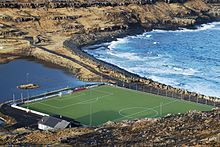Eiði
|
||

|
||
| position | 62 ° 19 ′ N , 7 ° 6 ′ W | |
|
Resident rank |
621 (2016) |
|
| Commune | Eiðis communa | |
| Post Code | FO 470 | |
| Markatal | ||
|
Grammar dative (in / from ...) genitive (after ...) |
á / av Eiði til Eiðis |
|
| Football club: EB / Streymur | ||
Eiði [ ˈaɪ̯jɪ ] (literally translated: isthmus ; Danish : Ejde ) is a place of the Faroe Islands in the far northwest of Eysturoys .
Eiði is one of the larger villages of the Faroe Islands and the capital of the municipality of the same name ( Eiðis kommuna ), to which the towns of Ljósá and Svínáir belong. At the beginning of 2016 there were 687 inhabitants in the municipality, 621 of them in Eiði itself. Eiði is one of the rural communities in the Faroe Islands that is experiencing an increase in population.
The place appears for the first time in written sources in the 14th century; however, it is assumed that people settled here during the time of the conquest. The church dates from 1881.
The most important hydroelectric power station in the Faroe Islands has been located here since 1986 . It gets its water from the lake Eiðisvatn to the southeast and higher up .
In the north is the 343 meter high Eiðiskollur , which is in front of the two famous cliffs Risin and Kellingin . East of the place rises with the 882 meter high Slættaratindur , the highest mountain in the Faroe Islands. The road to Gjógv leads along there .
In addition to the myth of Risin and Kellingin, this is also where the legend of "the elven woman's childbirth " ( Huldukonan í barnsneyð ) comes from .
The former soccer field "niðri á Mølini" in the northeast of Eiði was considered to be one of the most beautiful in the entire Danish kingdom due to its scenic location. Since April 2015, there is a year-round campsite with spaces for caravans and mobile homes. Hotel Eiði used to be in the village, but it has been closed since 2011. A small local history museum with a so-called Roykstova ("smoking room") is located in a renovated farmhouse in the center of the village.
In Eiði there is also a LORAN-C transmission station, which was once operated by Denmark. When Denmark wanted to close the station, France took over the operation.
A special feature of the Faroese language is the use of the prepositions á (to) and av (from) in relation to Eiði. It is called eg búgvi á Eiði ("I live on Eiði") and eg eri av Eiði ("I am from Eiði") instead of í (in) and úr (from) Eiði. This apparent curiosity is explained by the fact that Eiði means “isthmus”, ie isthmus. In German, too, one is on an isthmus or comes from it.
Sons and daughters of Eiðis
- Sigrun Gunnarsdóttir Nic Lassen (* 1950), painter
- Heidi Andreasen (* 1985), successful swimmer in international disabled sports
literature
- Óli Egilstrøð: Úr Eiðis søgu . Eiði: Grunnurin Lækjan 2004, ISBN 99918-3-152-5 (415 pages) ("From Eiði's story", in Faroese) Homepage of the book
Web links
- Photos and information in English, Danish and Italian
- Official website in Faroese and English
Individual evidence
- ↑ Fólkatalsbroytingar skiftar á fødd, deyð, flutt og bygd, mánaðarliga (1985-2016) , hagstova.fo
- ↑ Hvussu gomul er bygdin , heimabeiti.fo
- ↑ Huldukonan í barnsneyð , snar.fo (in Faroese)
- ↑ Eiði Camping , calameo.com
- ↑ The case for Loran ( Memento of the original from September 14, 2012 in the Internet Archive ) Info: The archive link was inserted automatically and has not yet been checked. Please check the original and archive link according to the instructions and then remove this notice. , loran.org
- ↑ LORAN C STATION: EJDE . loran-europe.eu. Archived from the original on August 1, 2012. Retrieved October 19, 2016. (in English)



